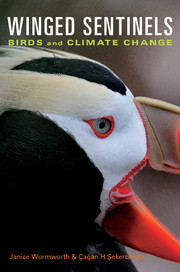Book contents
- Frontmatter
- CONTENTS
- ACKNOWLEDGEMENTS
- Introduction: The Free Advice of Birds
- Chapter 1 Phenology: Seasonal Timing and Mismatch
- Chapter 2 Migratory Birds Face Climate Turbulence
- Chapter 3 Range Shifts and Reshuffled Communities
- Chapter 4 Seabirds Herald Ocean Changes
- Chapter 5 Climate Change, Abundance and Extinction
- Chapter 6 Tropical Warming and Habitat Islands
- Chapter 7 Shifting Ground on Conservation
- NOTES
- INDEX
- PLATE SECTION
- PLATE SECTION
- PLATE SECTION
Chapter 4 - Seabirds Herald Ocean Changes
Published online by Cambridge University Press: 05 March 2012
- Frontmatter
- CONTENTS
- ACKNOWLEDGEMENTS
- Introduction: The Free Advice of Birds
- Chapter 1 Phenology: Seasonal Timing and Mismatch
- Chapter 2 Migratory Birds Face Climate Turbulence
- Chapter 3 Range Shifts and Reshuffled Communities
- Chapter 4 Seabirds Herald Ocean Changes
- Chapter 5 Climate Change, Abundance and Extinction
- Chapter 6 Tropical Warming and Habitat Islands
- Chapter 7 Shifting Ground on Conservation
- NOTES
- INDEX
- PLATE SECTION
- PLATE SECTION
- PLATE SECTION
Summary
Vulnerable and responsive marine indicators
El Niño and the equatorial penguin
On the otherworldly, black lava coasts of the Galápagos Islands, the plight of a small penguin illustrates why seabirds’ dual existence could be a liability under changing climate conditions. The Galápagos Islands, famed for Darwin's finches and marine iguanas, are perhaps less well known for the most northerly of penguin species. Endemic Galápagos penguins, Spheniscus mendiculus, probably descended from Humboldt penguins, S. humboldti, that hitched a ride from Chile or Peru on the cold, northward-flowing Humboldt Current to the Galápagos. The only penguin living and breeding on the equator, it also has among the smallest ranges and populations of any penguin species.
These penguins’ continued survival also hinges on the vagaries of ocean currents. Great concentrations of fish occur in the Galápagos Archipelago's western portion, where the bottom-flowing Equatorial Under Current (also known as the Cromwell Current) bumps up against the islands. This cold, nutrient-rich upwelling allows tropical and cold-water life to coexist. It also helps explain the penguins’ presence on the equator, and why their numbers are concentrated along the western islands where they have ready access to these productive waters.
- Type
- Chapter
- Information
- Winged SentinelsBirds and Climate Change, pp. 95 - 126Publisher: Cambridge University PressPrint publication year: 2011

